Différences entre versions de « Bluefruit-LE-Shield-HIDKeyboard »
| (16 versions intermédiaires par le même utilisateur non affichées) | |||
| Ligne 1 : | Ligne 1 : | ||
{{Bluefruit-LE-Shield-NAV}} | {{Bluefruit-LE-Shield-NAV}} | ||
| − | |||
| − | |||
== Le croquis HIDKeyboard == | == Le croquis HIDKeyboard == | ||
| − | + | L'exemple '''HIDKeyboard''' vous montre comment utiliser les commandes AT pour la fonctionnalité HID keyboard afin d'envoyer des données clavier vers n'importe quel périphérique Android ou iOS (supportant BLE). Cela fonctionne également avec les autres périphériques supportant la spécification "BLE HID peripherals". | |
== Ouvrir le croquis == | == Ouvrir le croquis == | ||
| − | + | Pour ouvrir le croquis ATCommand, cliquez sur le menu '''Fichiers > Exemples > Adafruit_BluefruitLE_nRF51''' dans Arduino IDE puis sélectionnez '''hidkeyboard''': | |
{{ADFImage|Bluefruit-LE-Shield-HIDKeyboard-00.png}} | {{ADFImage|Bluefruit-LE-Shield-HIDKeyboard-00.png}} | ||
| − | + | Cela ouvrira l'exemple dans l'environnement de développement, comme visible ci-dessous: | |
{{ADFImage|Bluefruit-LE-Shield-HIDKeyboard-01.png}} | {{ADFImage|Bluefruit-LE-Shield-HIDKeyboard-01.png}} | ||
== Configuration == | == Configuration == | ||
| − | + | Vérifiez la page '''Configuration''' présenter plus tôt dans le tutoriel! Il est important de configurer le croquis pour utiliser soit l'UART Logiciel/Matériel, soit le bus SPI Logiciel/Matériel correspondant à votre plateforme. Par défaut, le croquis utilise le bus SPI matériel | |
| − | + | Si vous utilisez le port série/UART logiciel ou matériel: | |
| − | * | + | * Ce tutoriel ne requière pas l'utilisation de la broche MODE, '''assurez-vous d'avoir l'interrupteur en position CMD''' si vous ne configurer pas (et ne connectez pas) la broche MODE. |
| − | * | + | * N'oubliez pas de '''connecter la broche CTS sur la masse/GND du Bluefruit si vous n'utilisez pas le signal CTS!''' (Le Flora l'a déjà branché à la masse) |
== Exécuter le croquis == | == Exécuter le croquis == | ||
| − | + | Une fois le croquis téléversé sur votre carte Arduino, vous pouvez ouvrir le moniteur série via le menu '''Outils > Moniteur série'''. Assurez-vous que le débit (Baud rate) soit configuré sur '''115200''' bauds (en bas à droite): | |
{{ADFImage|Bluefruit-LE-Shield-HIDKeyboard-10.png}} | {{ADFImage|Bluefruit-LE-Shield-HIDKeyboard-10.png}} | ||
| − | |||
| − | |||
| − | |||
| − | |||
| − | |||
| − | |||
| − | |||
| − | |||
| − | |||
| − | |||
| − | |||
| − | |||
| − | |||
| − | |||
| − | |||
| − | |||
| − | |||
| − | |||
| − | |||
| − | |||
| − | |||
| − | |||
| − | |||
| − | |||
| − | |||
| − | |||
| − | |||
| − | |||
| − | |||
| − | |||
| − | |||
| − | |||
| − | |||
| − | |||
| − | |||
| − | |||
| − | |||
| − | |||
| − | |||
| − | |||
| − | |||
| − | |||
| − | |||
| − | |||
| − | |||
| − | |||
| − | |||
| − | |||
| − | |||
| − | |||
| − | |||
| − | |||
| − | |||
| − | |||
| − | |||
| − | |||
| − | |||
| − | |||
| − | |||
| − | |||
| − | |||
| − | |||
| − | |||
| − | |||
| − | |||
| − | |||
| − | |||
| − | |||
| − | |||
| − | |||
| − | |||
| − | |||
| − | |||
| − | |||
| − | |||
| − | |||
| − | |||
| − | |||
| − | |||
| − | |||
| − | |||
| − | |||
| − | |||
== Lier le clavier HID == | == Lier le clavier HID == | ||
| − | + | Avant de pouvoir utiliser le clavier "HID keyboard", il sera nécessaire de le lié/l'appairer avec votre téléphone ou PC. Le mécanisme d'appairage (''bonding'' en anglais) permet d'établir une connexion permanente entre les deux périphérique. Cela signifie que dès que votre téléphone ou PC redétecte ce module Bluefruit LE module bien précis alors il est connecté automatiquement. | |
| − | + | La procédure exacte à utilisé pour faire l'appairage varie d'une plateforme à l'autre. | |
| − | {{ambox-stop|text= | + | {{ambox-stop|text=Lorsque vous n'avez plus besoin de l'appairage d'un module, ou si vous désirez re-appairer le périphérique Bluefruit LE sur un autre appareil, alors il faut effacer les informations d'appairage stocké sur le téléphone ou ordinateu... sinon il ne sera pas possible de le connecter avec un nouveau périphérique! }} |
| − | == Android == | + | === Android === |
| − | + | Pour lier le clavier (''keyboard'') sur un périphérique Android compatible BLE, rendez-vous dans l'application '''Paramètres''' (''Settings'' en anglais) et cliquez sur l'icon '''Bluetooth'''. | |
| − | {{ambox|text= | + | {{ambox|text=Ces captures d'écran son basées sur un Android 5.0 fonctionnant sur un Nexus 7 2013. L'apparence peut varier d'un périphérique à l'autre et d'une version de l'OS à l'autre.}} |
{{ADFImage|Bluefruit-LE-Shield-HIDKeyboard-20.jpg}} | {{ADFImage|Bluefruit-LE-Shield-HIDKeyboard-20.jpg}} | ||
| − | + | Dans le volet de configuration Bluetooth vous pouvez voir la liste des périphériques disponibles. Vous devriez y voir le module Bluefruit LE s’annonçant sous le nom '''Bluefruit Keyboard''': | |
{{ADFImage|Bluefruit-LE-Shield-HIDKeyboard-21.jpg}} | {{ADFImage|Bluefruit-LE-Shield-HIDKeyboard-21.jpg}} | ||
| − | + | Sélectionner le périphérique permet de démarrer le processus d'appairage. Processus qui se termine par le placement du périphérique "Bluefruit Keyboard" dans la liste des produits appairés (''Paired devices'' en anglais). Le libellé sous le périphérique devrait indiqué 'Connecté' (ou ''Connected'' en anglais): | |
{{ADFImage|Bluefruit-LE-Shield-HIDKeyboard-22.jpg}} | {{ADFImage|Bluefruit-LE-Shield-HIDKeyboard-22.jpg}} | ||
| − | + | Pour effacer les information d'appairage, il faut cliquer sur l'icon en forme de roue dentée en regard du périphérique puis cliquer sur le bouton "Abandonner/Relâcher" (''Forget'' en anglais): | |
{{ADFImage|Bluefruit-LE-Shield-HIDKeyboard-23.jpg}} | {{ADFImage|Bluefruit-LE-Shield-HIDKeyboard-23.jpg}} | ||
| − | == iOS == | + | === iOS === |
| − | + | Pour lier le "clavier" sur un périphérique iOS, rendez-vous dans l'application '''Configuration''' (''''Settings'' en anglais) de votre téléphone et cliquer sur le point de menu '''Bluetooth'''. | |
| − | + | Le clavier devrait apparaître sous la liste '''AUTRES PERIPHERIQUES''' (''OTHER DEVICES'' en anglais): | |
{{ADFImage|Bluefruit-LE-Shield-HIDKeyboard-30.jpg}} | {{ADFImage|Bluefruit-LE-Shield-HIDKeyboard-30.jpg}} | ||
| − | + | Une fois le processus d'appairage terminé, le périphérique est déplacé dans la catégorie '''MES PERIPHERIQUES''' (''MY DEVICES'' en anglais). Il sera alors possible de commencer à utiliser le modul e Bluefruit LE comme un clavier: | |
{{ADFImage|Bluefruit-LE-Shield-HIDKeyboard-31.jpg}} | {{ADFImage|Bluefruit-LE-Shield-HIDKeyboard-31.jpg}} | ||
| − | + | Pour abandonner l'appairage, cliquez sur l'icone 'info' et sélectionnez ensuite l'option '''Abandonner ce périphérique''' (''Forget this Device'' en anglais). | |
{{ADFImage|Bluefruit-LE-Shield-HIDKeyboard-32.jpg}} | {{ADFImage|Bluefruit-LE-Shield-HIDKeyboard-32.jpg}} | ||
| − | == OS X == | + | === OS X === |
| − | + | Pour appairer le clavier sur un périphérique OS X device, rendez vous dans la fenêtre des '''Préférence Bluetooth''' et cliquez sur le bouton '''Appairer''' (ou ''Pair'') en face du périphérique '''Bluefruit Keyboard''' (tel qu'il est nommé dans le croquis d'exemple): | |
{{ADFImage|Bluefruit-LE-Shield-HIDKeyboard-40.png}} | {{ADFImage|Bluefruit-LE-Shield-HIDKeyboard-40.png}} | ||
| − | + | Une fois appairé, il est possible d'abandonner l'appairage en cliquant sur l'icone 'x' situe à côté du périphérique '''Bluefruit Keyboard''': | |
{{ADFImage|Bluefruit-LE-Shield-HIDKeyboard-41.png}} | {{ADFImage|Bluefruit-LE-Shield-HIDKeyboard-41.png}} | ||
| − | ... | + | ... et cliquer ensuite sur le bouton '''Enlever''' (''Remove'' en anglais) lorsque la fenêtre de confirmation apparaît: |
{{ADFImage|Bluefruit-LE-Shield-HIDKeyboard-42.png}} | {{ADFImage|Bluefruit-LE-Shield-HIDKeyboard-42.png}} | ||
{{Bluefruit-LE-Shield-TRAILER}} | {{Bluefruit-LE-Shield-TRAILER}} | ||
Version actuelle datée du 26 mai 2017 à 14:55
Le croquis HIDKeyboard
L'exemple HIDKeyboard vous montre comment utiliser les commandes AT pour la fonctionnalité HID keyboard afin d'envoyer des données clavier vers n'importe quel périphérique Android ou iOS (supportant BLE). Cela fonctionne également avec les autres périphériques supportant la spécification "BLE HID peripherals".
Ouvrir le croquis
Pour ouvrir le croquis ATCommand, cliquez sur le menu Fichiers > Exemples > Adafruit_BluefruitLE_nRF51 dans Arduino IDE puis sélectionnez hidkeyboard:
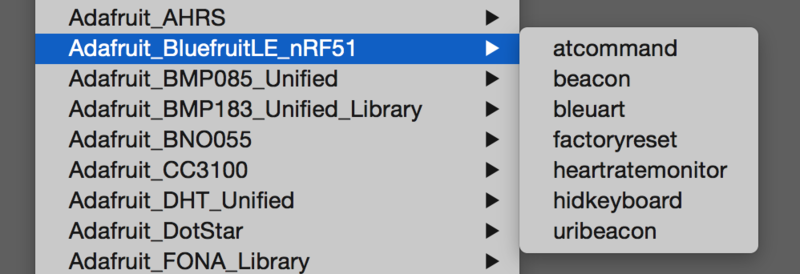
Crédit: AdaFruit Industries www.adafruit.com
Cela ouvrira l'exemple dans l'environnement de développement, comme visible ci-dessous:
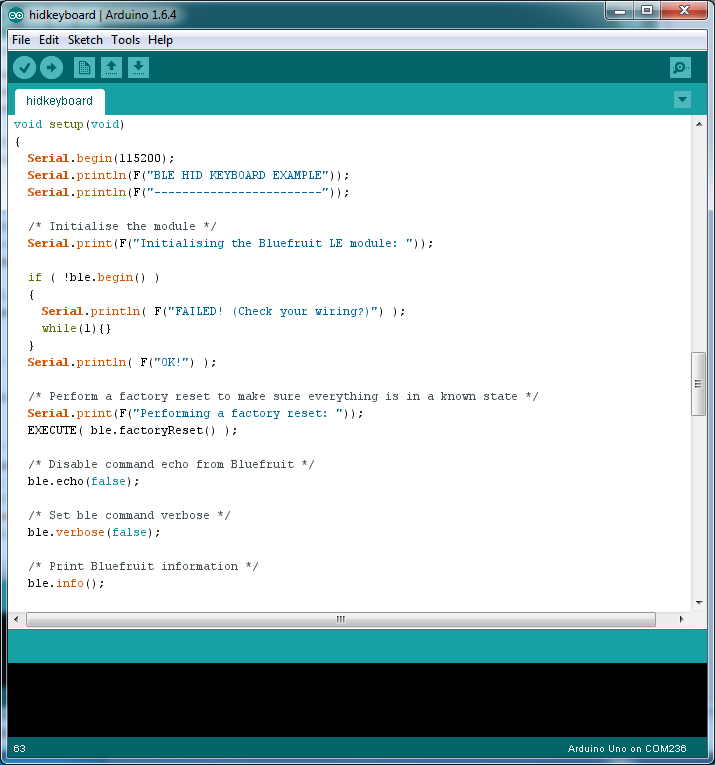
Crédit: AdaFruit Industries www.adafruit.com
Configuration
Vérifiez la page Configuration présenter plus tôt dans le tutoriel! Il est important de configurer le croquis pour utiliser soit l'UART Logiciel/Matériel, soit le bus SPI Logiciel/Matériel correspondant à votre plateforme. Par défaut, le croquis utilise le bus SPI matériel
Si vous utilisez le port série/UART logiciel ou matériel:
- Ce tutoriel ne requière pas l'utilisation de la broche MODE, assurez-vous d'avoir l'interrupteur en position CMD si vous ne configurer pas (et ne connectez pas) la broche MODE.
- N'oubliez pas de connecter la broche CTS sur la masse/GND du Bluefruit si vous n'utilisez pas le signal CTS! (Le Flora l'a déjà branché à la masse)
Exécuter le croquis
Une fois le croquis téléversé sur votre carte Arduino, vous pouvez ouvrir le moniteur série via le menu Outils > Moniteur série. Assurez-vous que le débit (Baud rate) soit configuré sur 115200 bauds (en bas à droite):
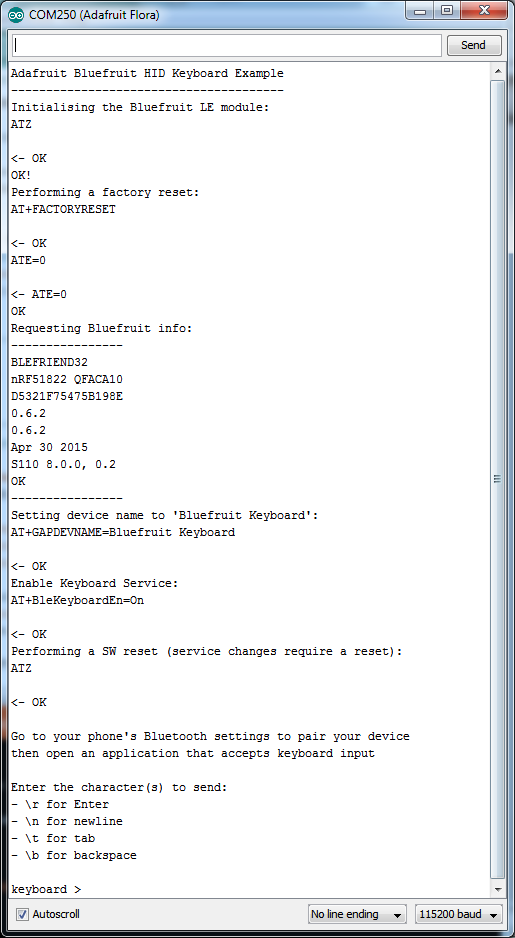
Crédit: AdaFruit Industries www.adafruit.com
Lier le clavier HID
Avant de pouvoir utiliser le clavier "HID keyboard", il sera nécessaire de le lié/l'appairer avec votre téléphone ou PC. Le mécanisme d'appairage (bonding en anglais) permet d'établir une connexion permanente entre les deux périphérique. Cela signifie que dès que votre téléphone ou PC redétecte ce module Bluefruit LE module bien précis alors il est connecté automatiquement.
La procédure exacte à utilisé pour faire l'appairage varie d'une plateforme à l'autre.
| Lorsque vous n'avez plus besoin de l'appairage d'un module, ou si vous désirez re-appairer le périphérique Bluefruit LE sur un autre appareil, alors il faut effacer les informations d'appairage stocké sur le téléphone ou ordinateu... sinon il ne sera pas possible de le connecter avec un nouveau périphérique! |
Android
Pour lier le clavier (keyboard) sur un périphérique Android compatible BLE, rendez-vous dans l'application Paramètres (Settings en anglais) et cliquez sur l'icon Bluetooth.
| Ces captures d'écran son basées sur un Android 5.0 fonctionnant sur un Nexus 7 2013. L'apparence peut varier d'un périphérique à l'autre et d'une version de l'OS à l'autre. |
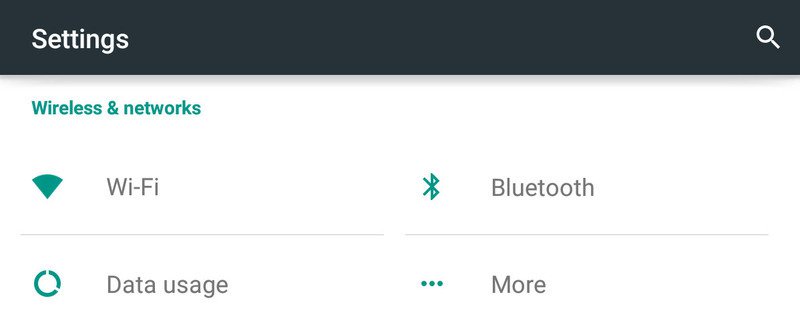
Crédit: AdaFruit Industries www.adafruit.com
Dans le volet de configuration Bluetooth vous pouvez voir la liste des périphériques disponibles. Vous devriez y voir le module Bluefruit LE s’annonçant sous le nom Bluefruit Keyboard:
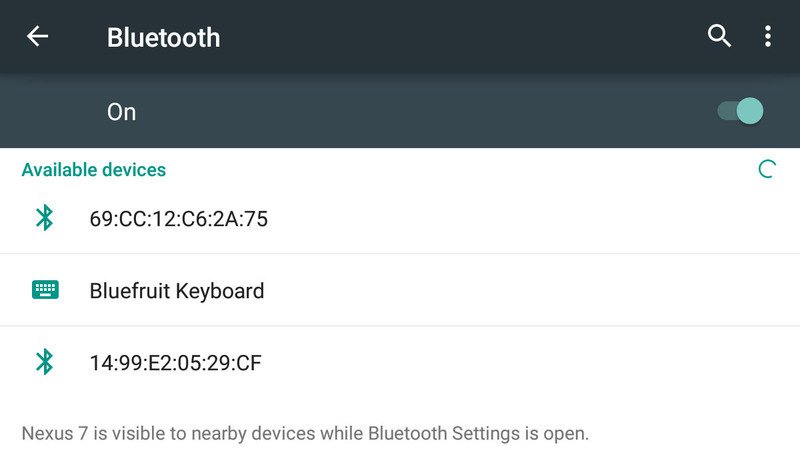
Crédit: AdaFruit Industries www.adafruit.com
Sélectionner le périphérique permet de démarrer le processus d'appairage. Processus qui se termine par le placement du périphérique "Bluefruit Keyboard" dans la liste des produits appairés (Paired devices en anglais). Le libellé sous le périphérique devrait indiqué 'Connecté' (ou Connected en anglais):

Crédit: AdaFruit Industries www.adafruit.com
Pour effacer les information d'appairage, il faut cliquer sur l'icon en forme de roue dentée en regard du périphérique puis cliquer sur le bouton "Abandonner/Relâcher" (Forget en anglais):
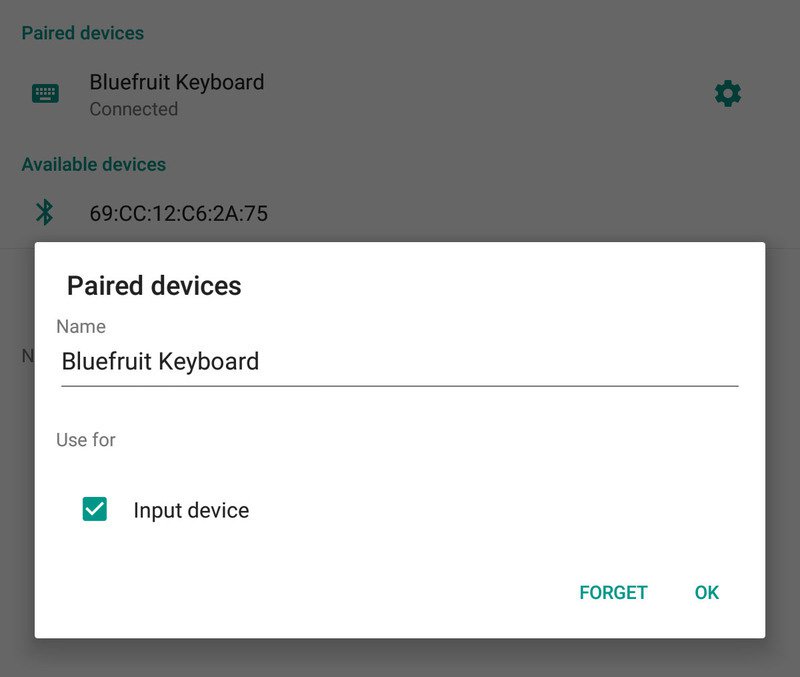
Crédit: AdaFruit Industries www.adafruit.com
iOS
Pour lier le "clavier" sur un périphérique iOS, rendez-vous dans l'application Configuration' ('Settings en anglais) de votre téléphone et cliquer sur le point de menu Bluetooth.
Le clavier devrait apparaître sous la liste AUTRES PERIPHERIQUES (OTHER DEVICES en anglais):
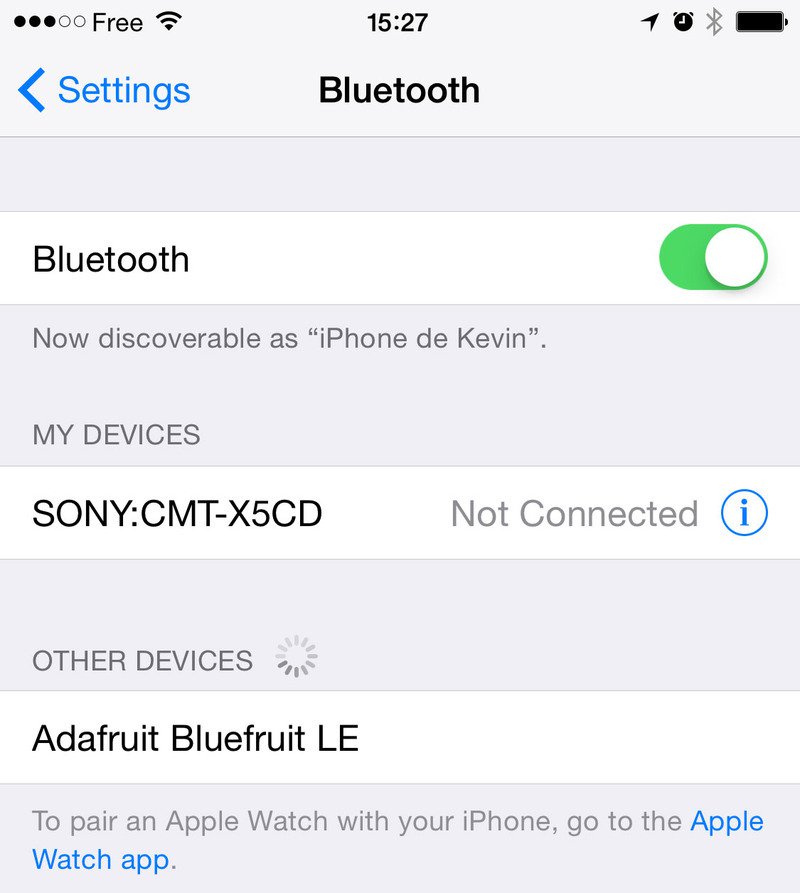
Crédit: AdaFruit Industries www.adafruit.com
Une fois le processus d'appairage terminé, le périphérique est déplacé dans la catégorie MES PERIPHERIQUES (MY DEVICES en anglais). Il sera alors possible de commencer à utiliser le modul e Bluefruit LE comme un clavier:

Crédit: AdaFruit Industries www.adafruit.com
Pour abandonner l'appairage, cliquez sur l'icone 'info' et sélectionnez ensuite l'option Abandonner ce périphérique (Forget this Device en anglais).
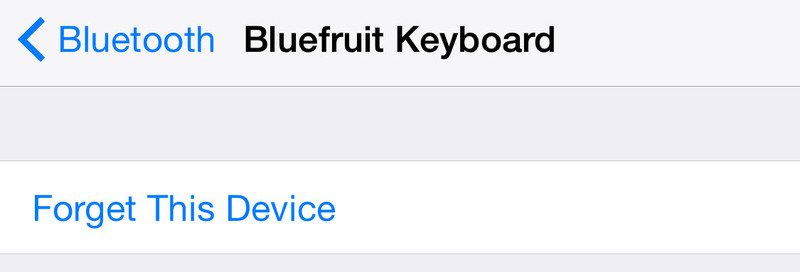
Crédit: AdaFruit Industries www.adafruit.com
OS X
Pour appairer le clavier sur un périphérique OS X device, rendez vous dans la fenêtre des Préférence Bluetooth et cliquez sur le bouton Appairer (ou Pair) en face du périphérique Bluefruit Keyboard (tel qu'il est nommé dans le croquis d'exemple):
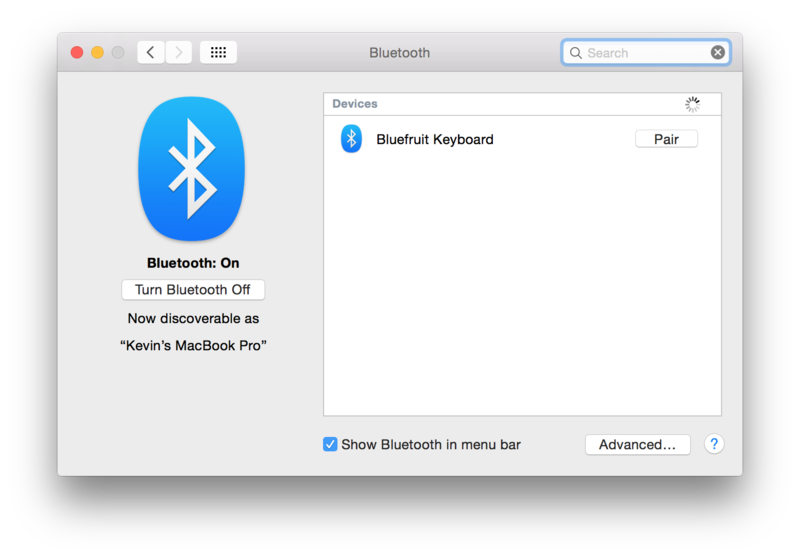
Crédit: AdaFruit Industries www.adafruit.com
Une fois appairé, il est possible d'abandonner l'appairage en cliquant sur l'icone 'x' situe à côté du périphérique Bluefruit Keyboard:
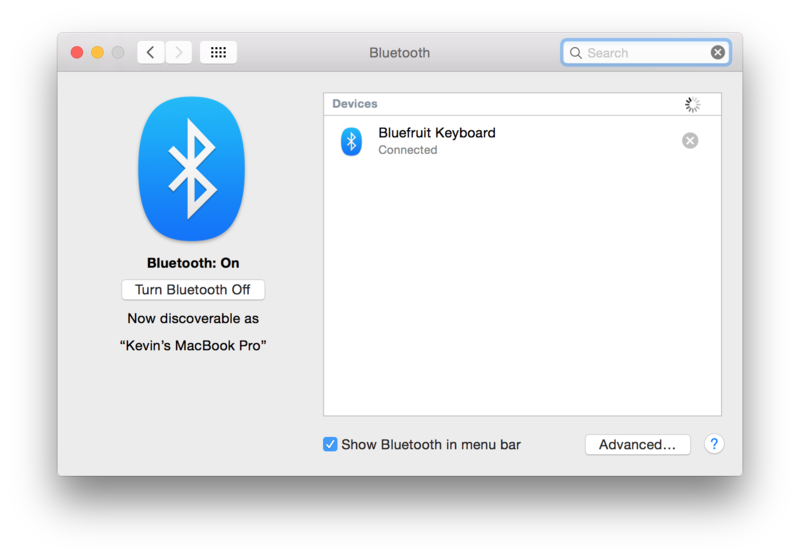
Crédit: AdaFruit Industries www.adafruit.com
... et cliquer ensuite sur le bouton Enlever (Remove en anglais) lorsque la fenêtre de confirmation apparaît:

Crédit: AdaFruit Industries www.adafruit.com
Basé sur "Bluefruit LE Shield" d'Adafruit Industries, écrit par
Kevin Townsend - Traduit en Français par shop.mchobby.be CC-BY-SA pour la traduction
Toute copie doit contenir ce crédit, lien vers cette page et la section "crédit de traduction".
Based on "Bluefruit LE Shield" from Adafruit Industries, written by
Kevin Townsend - Translated to French by shop.mchobby.be CC-BY-SA for the translation
Copies must includes this credit, link to this page and the section "crédit de traduction" (translation credit).
Traduit avec l'autorisation d'AdaFruit Industries - Translated with the permission from Adafruit Industries - www.adafruit.com